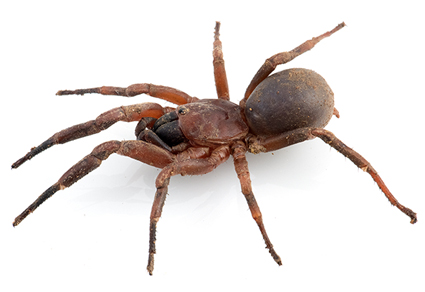Abstract
Seven new species of the enigmatic spider family Paratropididae are described from Ecuador. All new species belong to the genus Paratropis: P. carcosita sp. nov. (♀), P. pukallucha sp. nov. (♂♀), P. esmeraldas sp. nov. (♂♀), P. kapak sp. nov. (♂♀), P. pasochoa sp. nov. (♀), P. arenosa sp. nov. (♀) and P. cryptica sp. nov. (♂♀). A distribution map of all newly described species is presented.
References
- Almeida, M.Q. & Morais, J.W. de (2022) A new species of Paratropis Simon, 1889 (Araneae: Paratropididae) from Guyana. EntomoBrasilis, 15 (e1004), 1–5. https://doi.org/10.12741/ebrasilis.v15.e1004
- Álvarez-Padilla, F. & Hormiga, G. (2007) A protocol for digesting internal soft tissues and mounting spiders for scanning electron microscopy. Journal of Arachnology, 35, 538–542. https://doi.org/10.1636/Sh06-55.1
- Dupérré, N. (2015) Description of the first visually cryptic species of Paratropis (Araneae: Paratropididae) from Ecuador. Journal of Arachnology, 43 (3), 327–330. https://doi.org/10.1636/arac-43-03-327-330
- Dupérré, N. & Tapia, E. (2020) On the putatively incorrect identification and “redescription” of Paratropis elicioi Dupérré 2015 (Paratropididae, Araneae) with the description of two new sympatric species from Ecuador. Zootaxa, 4869 (3), 326–346. https://doi.org/10.11646/zootaxa.4869.3.2
- Guevara, J. & Morales, C. (2013a) Región Andes. Bosque siempreverde piemontano de Cordillera Occidental de los Andes. In: Galeras, R., Guevara, J.E., Medina-Torres, B., Chinchero, M.A. & Herrera, X. (Eds.), Sistema de Clasificación de Ecosistemas del Ecuador Continental. Ministerio del Ambiente del Ecuador, Quito, pp. 83–84.
- Guevara, J.E., Mogollón, H., Cerón, C. & Josse, C. (2013b) Región Andes. Bosque siempreverde piemontano del Norte de la Cordillera Oriental de los Andes. In: Galeras, R., Guevara, J.E., Medina-Torres, B., Chinchero, M.A. & Herrera, X. (Eds.), Sistema de Clasificación de Ecosistemas del Ecuador Continental. Ministerio del Ambiente del Ecuador, Quito, pp. 108–110.
- Guevara, J.E., Pitman, N., Mogollón, H., Cerón, C. & Palacios, W. (2013c) Región Amazonía. Bosque siempreverde de tierras bajas del Aguarico-Putumayo-Caquetá. In: Galeras, R., Guevara, J.E., Medina-Torres, B., Chinchero, M.A. & Herrera, X. (Eds.), Sistema de Clasificación de Ecosistemas del Ecuador Continental. Ministerio del Ambiente del Ecuador, Quito, pp. 175–177.
- Iglesias, J. & Santiana J. (2013) Región littoral. Bosque siempreverde estacional de tierras bajas del Jama-Zapotillo. In: Galeras, R., Guevara, J.E., Medina-Torres, B., Chinchero, M.A. & Herrera, X. (Eds.), Sistema de Clasificación de Ecosistemas del Ecuador Continental. Ministerio del Ambiente del Ecuador, Quito, pp. 55–56.
- Morales, C. & Guevara, J. (2013) Región littoral. Bosque siempreverde de tierras bajas del Chocó Ecuatorial. In: Galeras, R., Guevara, J.E., Medina-Torres, B., Chinchero, M.A., Herrera, X. (Eds.), Sistema de Clasificación de Ecosistemas del Ecuador Continental. Ministerio del Ambiente del Ecuador, Quito, pp. 38–39.
- Perafán, C., Galvis, W. & Pérez-Miles, F. (2019) The first Paratropididae (Araneae, Mygalomorphae) from Colombia: new genus, species and records. ZooKeys, 830, 1–31. https://doi.org/10.3897/zookeys.830.31433
- Pickard-Cambridge, F.O. (1896) On the Theraphosidae of the lower Amazons: being an account of the new genera and species of this group of spiders discovered during the expedition of the steamship «Faraday» up the river Amazons. Proceedings of the Zoological Society of London, 64 (3), 716–766, pls. 33–35. https://doi.org/10.1111/j.1096-3642.1896.tb03076.x
- Raven, R.J. (1985) The spider infraorder Mygalomorphae (Araneae): cladistics and systematics. Bulletin of the American Museum of Natural History, 182, 1–180.
- Sherwood, D., Lucas, S.M. & Brescovit, A.D. (2022) Redescription of the holotype female of Anisaspoides gigantea F. O. Pickard-Cambridge, 1896 with discussion and typification of Anisaspis tuberculata Simon, 1892 (Araneae: Paratropididae). Revista Ibérica de Aracnología, 41, 91–95.
- Sherwood, D., Lucas, S.M. & Brescovit, A.D. (2023) Paratropis tortue sp. nov., a new species of mud spider from French Guiana (Araneae: Paratropididae). Faunitaxys, 11 (10), 1–3. https://doi.org/10.57800/faunitaxys-11(10)
- Simon, E. (1889) Voyage de M. E. Simon au Venezuela (Décembre 1887–Avril 1888). 4e Mémoire. Arachnides. Annales de la Société Entomologique de France, Series 6, 9, 169–220.
- Simon, E. (1892) On the spiders of the island of St. Vincent. Part 1. Proceedings of the Zoological Society of London, 59 (4), 549–575. [1897]
- Valdez-Mondragón, A., Mendoza, J.I. & Francke, O.F. (2014) First record of the mygalomorph spider family Paratropididae (Arachnida, Araneae) in North America with the description of a new species of Paratropis Simon from Mexico, and with new ultramorphological data for the family. ZooKeys, 416, 1–21. https://doi.org/10.3897/zookeys.416.7253
- Valencia, R. & Jørgensen, P.M. (2008) Composition and Structure of a Humid Montane Forest on the Pasochoa Volcano, Ecuador. Nordic Journal of Botany, 12 (2), 239–247. https://doi.org/10.1111/j.1756-1051.1992.tb01301.x
- WSC (2024) World Spider Catalog. Version 24. Natural History Museum Bern, Bern. Available from: http//wsc.nmbe.ch (accessed 6 December 2023)


